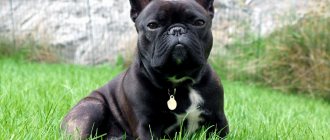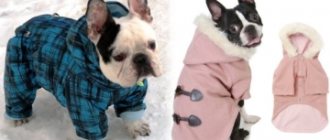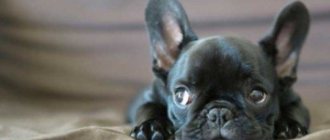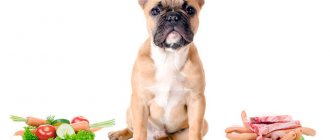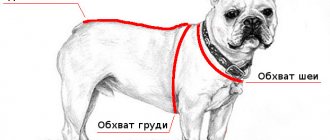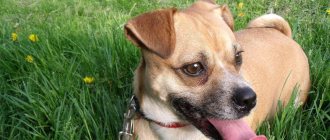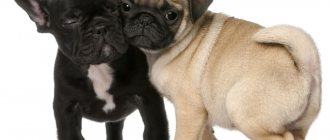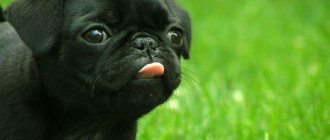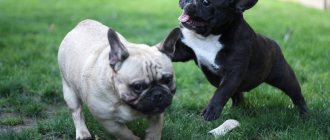This breed was developed by the French by crossing an English bulldog with a terrier. Initially, it was used for baiting bulls, which was due to the flat structure of its muzzle. But after the abolition of this type of entertainment, the French bulldog became a breed loved by millions due to its lively disposition, sociability and peacefulness.
French bulldog age 6 months
And besides, this little dog is distinguished by amazing courage and devotion to its owner. Currently, the most popular colors of the French Bulldog are four types: blue, black, white and brindle.
Breed characteristics and character
The breed has a very sociable character. French bulldogs are very attached to their owners. They love children and usually obediently tolerate any manifestations of feelings on their part. These dogs very sensitively sense the mood of their owners; they greet guests joyfully, but only if the owners themselves are happy with the guests.
Shows true fearlessness towards uninvited guests. Does not tolerate loneliness well, because it is very dependent on the owner, and is ready not to be separated from him at all if there is such an opportunity. Active, smart, curious. It's easy to learn new commands.
French bulldog age 3 years
Balanced, never shows aggression without a reason. Loves praise and affection. As for their personality traits, these dogs should be kept with you when walking; their playful, curious disposition can often lead them too far from their owner.
Very young children should not be allowed near, in order to avoid manifestations of parental instinct. But overall, he is a loyal friend, a ringleader, smart, brave and very sociable.
Dog nutritional features
Any puppy must be immediately accustomed to unknown foods. You can’t follow his lead if he ignores fresh food and immediately change it or improve the taste. The cunning man will quickly realize that his whims are taken into account, and will constantly bargain for a tastier dish.
For eating, one place is allocated, equipped with a pair of low cylindrical bowls: for food and water. Along with the “Frenchman” itself, the volume of the feeding container also grows, in the role of which (at first) old frying pans, pots and cups can be used.
There are several prohibited actions in organizing dog food:
- Do not use glassware (the dog may accidentally break it and get injured);
- do not place a wooden cup (the puppy will try it on his teeth);
- avoid containers with a spherical bottom (they are easy to tip over);
- do not feed from a cup purchased for growing up (the puppy will smear food on the bottom and get used to getting into it with his paws);
- do not teach people to eat from their hands (this is inconvenient for the owner, and the “French” will be spoiled by such serving of food);
- Don't feed your dog wherever you have to (this is a recipe for bad behavior such as stealing and begging).
Important! All bones, except large raw beef bones, more often called sugar bones, are completely excluded. And these are given infrequently, so as not to wear down the teeth.
Don't worry about the apparent monotony of dog food - the main thing is that it is healthy and full of vitamins. The latter, as you know, are more abundant in raw foods. Your task is to maintain a balance in your diet (1/3 should be fiber, 2/3 should be animal proteins (meat, fish, cottage cheese).
Everything that is cooked should not be too liquid/empty, nor too hot or cold (recommended food temperature is +20 +25 degrees).
Return to content
Breed standard
The French Bulldog breed standard is shown in the photo below. The dog itself is apparently large, strong, stocky, the females are a little lighter and more elegant, but just as powerful. The head is large, no more than one-sixth the length of the body.
French bulldogs of various colors
Height 27-35 for a cable, 24-32 for a female with a deviation of no more than one cm. Weight for a female is 8-13 kg, for a cable 9-14 kg with a deviation of no more than 500 g. The breed standard is presented in detail in the list:
- The head is massive and fits perfectly into two regular squares. The skull is flat, the back of the head is poorly defined, the forehead is convex, and the brow ridges are not prominent. The face is short, rectangular, cheeks and cheekbones are well developed. The nose is upturned, wide, dark in color, with wide nostrils. There are many folds on the face, but they should not rise above the eyes.
The French Bulldog's ears are bat-shaped. Wide, gradually widening at the bottom, rounded at the top. Placed far enough apart, vertical to the head, high.
When viewed from the front, the auricle is visible. The skin is thin and soft to the touch. The eyes are large, rounded, dark in color, with a conscious expression, slightly protruding, located quite far from each other.
French bulldog on the beach in summer
Eyelashes and eyelids of a dark color for any color. Teeth with correct bite, without gaps. The fangs are strong, the lower ones are more powerful than the upper ones. The lower jaw is slightly curved upward and has a U-shape. The neck is short, strong, set at an angle of 450 degrees, not too low, but not too high.
The scruff is strong, short, with a slight bend. The body is strong, rectangular, not too elongated. The line of the back is slightly curved from the withers to the croup. The chest is voluminous, convex and strong in front, square in shape. The back is muscular and wide. The limbs are strong. The front legs are vertical and powerful.
French bulldog playing with an ear of corn
The shoulders are well laid back and muscular. The hind legs are slightly elongated, set straight, the thighs are muscular, the claws are not very long, and are dark in color. The tail is thick at the base, set low, of standard or short length.
What ear diseases do French Bulldogs have?
Ear diseases (otitis) are divided into diseases of the outer and middle ear.
Otitis of the external ear includes otodectosis (ear scabies), caused by parasitic mites. The causes of middle ear inflammation can be viral or bacterial infections. Red ears in a French bulldog, swelling or creases may indicate mechanical damage to blood vessels due to a fight with other dogs or a bruise. The cause of the odor may be a fungal infection or ear scabies. If your French Bulldog is scratching its ears, then most likely the ear is infected with parasites or yeast fungus (otomycosis). Itching can also be caused by an allergic reaction to food ingredients or skincare products.
Care and maintenance
Before you buy a dog of this breed, you must take care of the conditions of its maintenance. It is necessary to prepare in advance the places where the dog will sleep and eat. Moreover, this should be taken seriously. Places near the radiator, in the corridor, next to the balcony or door are not suitable for a bulldog to sleep (this threatens the pet with overheating or hypothermia).
It is best to choose a place in the corner by the window. You need to buy a rug, sofa or house for sleeping in advance. The owner must choose what he likes best. The rug is easy to clean from wool; you only need to wash it when it gets dirty.
It is better to buy a sofa or house made of durable material so that the dog cannot bite through it, preferably large in size (the pet should be able to stretch out on it to its full height).
French bulldogs look suspiciously at the camera
In addition, you need to purchase two bowls made of plastic or stainless steel, one for water and the other for food. Choose the size based on the age of the pet. And of course, don’t forget about a soft brush for fur, a leash with a collar, rubber toys and shampoo.
After all the supplies have been purchased, you should take care of the safety of your pet. The fact is that French bulldog puppies are very active and curious, so you need to remove everything that can harm them, as well as everything that they can harm.
This includes various wires, shoes, cracks that are best closed so that the pet does not get stuck somewhere, dangerous or toxic substances that he may accidentally swallow, and so on.
After all precautions have been taken, the puppy is introduced to the environment of the house, showing him where he will sleep, eat and where to go to the toilet, and then begin to accustom him to hygiene procedures.
Black and white French bulldog outdoors
Caring for your pet includes several important points:
- Walking the bulldog. The walking time depends on the age of the dog. So, puppies should not be walked for more than 5-10 minutes, but as they grow older, this time should be gradually increased, and after one year the puppy needs to be walked for one to three hours. You should not take your pet outside in excessively cold or hot weather. Wool. French bulldogs need to be brushed 1-2 times a week; if necessary, for example during a coat change, they can be brushed more often. Hygiene. You can bathe bulldogs in water using shampoo no more than 3-4 times a year. The rest of the time they can be washed with warm water without any additives. Particular attention should be paid to the folds on their face; they are periodically wiped with warm water and lubricated with baby cream to prevent diaper rash. And of course, we must not forget from time to time to check their teeth for the presence of tartar, clean their ears and rinse their eyes with a tea solution.
Differences in caring for a puppy
Until the bulldog has grown up, its care has some features characteristic only of puppies. This should be taken into account if the Frenchie came to you very young, at the age of 1.5-2 months.
- Puppies under one year old are susceptible to a variety of diseases, which are not always safe. That is why they are vaccinated in accordance with a certain schedule (see table).
- It is important that the puppy is completely healthy at the time of vaccination. 10 days before vaccinations, the puppy undergoes deworming - elimination of internal parasites. Only after the first vaccination can you take the puppy outside.
| Vaccination procedure | Puppy age |
| 1st vaccination | 12 weeks (3 months) |
| 2nd vaccination | in 3-4 weeks |
| 3rd vaccination | 6-7 months (after changing teeth) |
| 4th vaccination | 12 months |
- A small bulldog should be outdoors as much as possible in the company of its owner and other dogs.
- The puppy should have a sufficient variety of toys. These can be balls, rags, ropes or rubber rings.
Relationships with children and cats
Judging by the reviews from our readers, the French Bulldog gets along well with both very young children and older children. He will try to look after the babies and guard the crib with the baby. You can tinker with preschoolers and play more active games. If you look at the photo, you can see how great he gets along with small children.
However, children do not always understand responsibility for a dog. It often happens that a small child picks up a bulldog in his arms, but does not hold it, and he falls to the ground with all his weight, which, I must say, is not small. The bulldog can suffer from such falls. Therefore, parents who keep bulldogs with their children must constantly monitor both of them.
But the French don’t like felines. On the street, if the dog is not on a leash, all cats will be scattered.
Of course, bulldogs should be weaned from chasing other animals, but this does not always work. It's a completely different matter if a bulldog puppy and a kitten grow up together. In this case, you couldn’t find better friends! The dog will protect the cat, and the cat will lick its fur in return. Perhaps they will even eat from the same bowl.
Nutrition
Due to the characteristics of the breed, the French Bulldog dog
Nowadays, there are two approaches to feeding a pet: natural food and commercial food. It is important to understand here that these two paths cannot be mixed in any way, as this can lead to serious allergic reactions. But each method individually has certain advantages.
Purchased food is, first of all, a saving of time and effort. If the owner chooses this path, he no longer needs to count how much the pet has eaten per day, and he does not need to spend a lot of time cooking.
However, store-bought food is not cheap, given the fact that French bulldogs cannot buy economy-class food, because it can harm their health (it is better to choose hypoallergenic premium or super-premium class). And natural nutrition has always been considered healthier.
This is the advantage of natural nutrition, but its disadvantage is that it has many subtleties. For example, bulldogs can only eat boiled meat (beef, lamb, or boneless poultry), cut into slices. You can also give your pet boiled liver, lung or spleen, cutting them into pieces. At the same time, meat should always make up half the portion, and no more.
In addition, bulldogs can be given boiled sea fish without bones. Cottage cheese, fermented baked milk and kefir are preferable among dairy products. You can cook porridge (rice or buckwheat) in meat broth or water. It is not prohibited to add boiled vegetables or fresh, thoroughly washed fruits to the portion. And finally, your pet should be fed six to three times a day, depending on its age (a puppy is fed more often).
Place for a dog in the house
The boudoir of a “Frenchman” is sacred territory: here he rests and feels absolutely safe . As soon as the puppy appears in the house, the owner introduces him to the bed, patting it with the words “Place! Place!". It is highly undesirable to change it, as this will confuse the dog, making it more difficult to train.
Requirements for setting up a dog area:
- the room should be dry, bright, with a small amount of furniture;
- Small objects with sharp edges should not be lying on the floor;
- It is better to place the rug in a corner, not far from the window;
- You can’t place a bed near a door, a radiator, or in a draft;
- you need to hide electrical wires;
- Any sharp sounds should be excluded (for example, from working tools and slamming doors).
Be prepared for the puppy to persistently climb onto your bed, sofa or chair. If you don’t stop the attempts right away, you will always be forced to share your bed with an insolent dog’s face.
French bulldogs, like most dogs, love to tear at their owner’s shoes, which is why they need to be washed after walking down the street (or put in a locked locker): dust and dirt accumulate various infections that threaten animals and humans.
Important! When your pet is resting on its bed, it should not be disturbed, much less punished. It is unknown what the reaction of the “French” will be, who considers the rug a 100% untouchable zone.
Remember that in the first days after the move, the puppy will gradually get used to the new living conditions and may whine at night. In this case, all family members in turn, or the owner himself, if he lives alone, can calm the sufferer.
Return to content
Possible diseases
Common diseases of the French bulldog are mainly associated with the structural features of its muzzle. Large eyes and ears, a flat nose - all this contributes to the occurrence of certain diseases if you do not pay enough attention to the pet’s hygiene.
Other causes of diseases include infections (to prevent them, it is necessary to get vaccinated), genetic characteristics and an unfavorable living environment.
French bulldog puppy age 2.5 months
One of the most common diseases of the French bulldog is conjunctivitis. Dust, a speck that gets into the eye, a flying midge or a blow from a branch can cause inflammation; if the chamomile infusion does not help, you should immediately contact a veterinarian, otherwise the disease can lead to loss of vision.
Your pet's ears are also at risk, so they need to be cleaned regularly. If the dog often scratches its ears, and purulent discharge can be seen in the auricle, then this is most likely a sign of otitis media.
This disease is caused by dirt, water, or fungus, which in turn can lead to otomycosis. In addition, it is important for the owner to be able to recognize the signs of allergies in their pet. These signs include: itching, rashes or spots on the skin, intestinal disorders, bad breath, sneezing.
When these symptoms appear, you need to try to find the cause of the allergic reaction; it could be food, shampoo, synthetic materials, pollen, insect bites. The source of the allergy should be eliminated immediately, and the pet must be shown to a veterinarian.
French food
This is exactly where we wanted to start, because feeding is the basis of strong immunity from an early age. This rule can be applied to all dogs, but especially to Frenchies. Due to the flattened muzzle with a wide mouth, it is difficult for the dog to eat food as such, especially if it is in a deep bowl.
It's just a nightmare because the bulldog literally twists and turns to eat all the crumbs. The leftovers are sweet, so to speak. But this is very inconvenient, do not torture your dog, buy a bowl that is flat with small sides and stable. By the way, the puppy’s stomach will not be happy with such food consumption and, in the end, the stomach will swell. If the belly is too hard when you feel it, be sure to contact your veterinarian. Very comfortable dog bowls on a stand; the attachments can be rearranged so that the bowl is at chest level.
Bloating can also occur for other reasons. For example, because you gave him liquid food. Together with such food, the puppy swallows large portions of air, but this does not happen with solid (dry) food. Don’t forget about clean water every day, change the water in the bowl on time. When feeding dry food, you need to monitor water consumption, let him drink in large quantities. This will prevent liver and stomach problems.
Price
The price of a French bulldog can range from 3 to 80 thousand rubles, depending on the purity of the breed, pedigree and other factors. This is not surprising, given the popularity and value of this breed. But the factors influencing its price are still worth considering in more detail:
- You can buy a dog second-hand for an average of 3 thousand rubles. When a female has puppies, and the owners need to somehow give these puppies away, they will completely agree to such a price. This option is suitable for those who are not too concerned about the purebred and pedigree of their pet. A purebred, purebred puppy can be bought in a professional nursery or from breeders for 10-20 thousand rubles, but in this case the puppy will not have a pedigree. But a purebred puppy with a pedigree will cost 20-80 thousand rubles, depending on physiological indicators and many other factors. The price of a puppy may also depend on its color.
So, lately the blue French bulldog and the price for it is usually greatly inflated. However, this color is a defect and does not meet the standard. The same is true with black color. But white puppies are very rare.
Walking a French bulldog, clothes
This dog is a bundle of energy that requires systematic release. They walk with her 2-3 times a day and for a long time (preferably from 1 to 3 hours). The walk should be shortened if it is chilly and chilly outside .
Due to the breed's predisposition to spinal diseases, the puppy is not allowed to run up the stairs until six months, and while he is in vaccination quarantine, he is not allowed outside. If you notice that the puppy is tired, pick him up or put him in a bag.
You should not let your Frenchie off the leash near the highway or walk it near playgrounds: not all parents will like this. During walks, the leash is unhooked only when the dog has learned to unquestioningly obey your commands.
Outdoor walks (in rain, wind and snow) should become the norm, but to make them more enjoyable, use special dog clothing and shoes. Boots, booties and booties are worn extremely rarely to protect the paw pads from the reagents used in winter to combat ice.
Clothing is worn more often, as it performs two functions: to protect the pet from hypothermia and to save the energy of the owner, who no longer needs to wash his dog (the dirt will remain on the waterproof overalls).
Some dog handlers are against dog clothing, arguing that it has a bad effect on fur growth and disrupts the body’s natural thermoregulation. Their opponents claim that the statement is true only in relation to long-haired breeds, and those with short fur (including bulldogs) are characterized by increased heat-loving behavior.
Particularly caring people protect the large ears of their “Frenchies” from the cold by placing hats (either hand- or machine-knitted) on them, which the dogs don’t really like, but it keeps them healthy.
Return to content
Tray training and walking outside
Toilet training begins in puppyhood and the process requires some time and patience. The ideal option is to place the puppy in a fenced-off area during training. The tray should have low sides so that the baby can climb into it. The bottom is covered with a diaper or absorbent napkins. Puppies usually go to the toilet after sleeping and eating. After feeding or waking up, you should take your dog to the prepared tray and keep him in it until he urinates.
If a small pet leaves a puddle on the floor, you need to soak a diaper or napkin in it and put it in the tray. Thus attracting to go to the tray next time. The puppy should be taken to the litter box after each feeding, developing the habit of going to the toilet after eating.
All soiled areas must be thoroughly washed without using ammonia products. You shouldn’t scold and punish your puppy for “surprises” until he’s six months old.
Reference. It has been noticed that over time the pet takes on the character traits of its owner.
When the baby is three months old and has received the necessary vaccinations, he can be walked outside. While the bulldog is small, it must be taken outside to the toilet after each feeding. It is advisable to choose a specific place for this; for the first time, you can take a napkin from the tray and place it next to the selected place so that the baby can understand that his toilet is located here.
It is recommended to walk your pet along one route - the smells will remind you to go to the toilet. At the end of the procedure, the puppy must be praised and rewarded with a treat.
